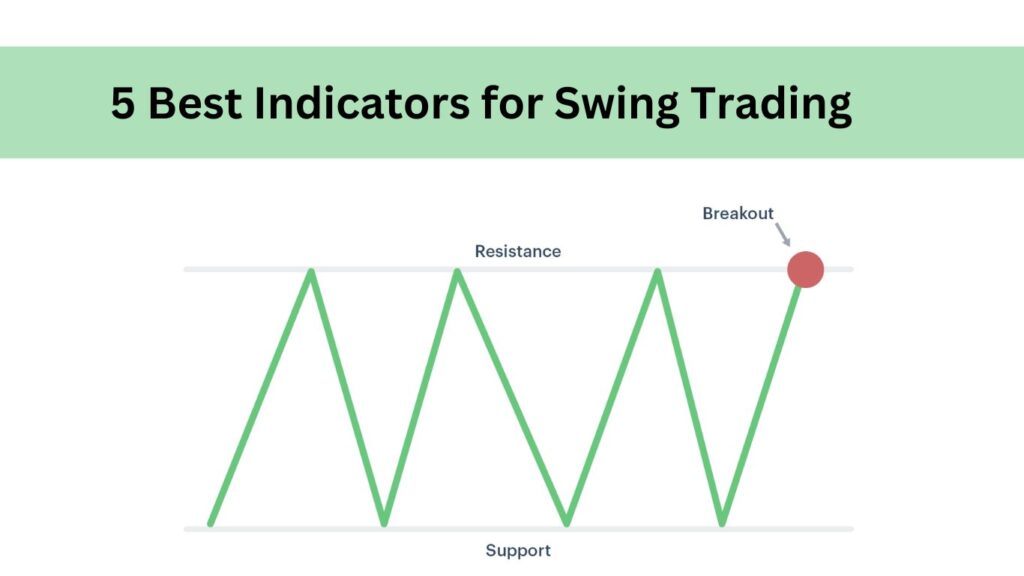Swing Trading एक ऐसी रणनीति है जिसमें ट्रेडर्स कुछ दिनों से लेकर कुछ हफ्तों तक की अवधि में छोटे से मध्यम अवधि के मूल्य परिवर्तनों को पकड़ने की कोशिश करते हैं। यह डे ट्रेडिंग से अलग है, जहाँ एक ही दिन में पोज़िशन खोली और बंद की जाती है। स्विंग ट्रेडर्स बाजार में उच्च और निम्न स्तरों की पहचान करके मूल्य स्विंग्स या ‘तरंगों’ से लाभ कमाने का लक्ष्य रखते हैं। इस लेख में, हम Swing Trading के लिए 5 बेहतरीन इंडिकेटर्स पर चर्चा करेंगे जो ट्रेंड्स, रिवर्सल्स, और मुनाफ़े वाले एंट्री पॉइंट्स की पहचान करने में आपकी मदद कर सकते हैं।
Swing Trading विशेष रूप से लोकप्रिय है क्योंकि यह डे ट्रेडिंग की तुलना में कम समय लेता है, फिर भी मूल्य में उतार-चढ़ाव से लाभ प्राप्त करने का अवसर देता है। ट्रेडर्स तकनीकी विश्लेषण और इंडिकेटर्स का उपयोग करके एंट्री और एग्ज़िट पॉइंट्स तय करते हैं।
Swing trading के लिए बेहतरीन इंडिकेटर्स की सूची
Swing trading के लिए कुछ सबसे प्रभावी इंडिकेटर्स में शामिल हैं:
मूविंग एवरेज कन्वर्जेन्स डाइवर्जेन्स (MACD)
रिलेटिव स्ट्रेंथ इंडेक्स (RSI)
बोलिंजर बैंड्स
फिबोनाची रिट्रेसमेंट
स्टोकास्टिक ऑस्सिलेटर
इन सभी इंडिकेटर्स का अपना अलग-अलग महत्व है और ये ट्रेडर्स को सही समय पर ट्रेड एंटर या एग्ज़िट करने के लिए जानकारी प्रदान करते हैं।
1. मूविंग एवरेज कन्वर्जेन्स डाइवर्जेन्स (MACD)
MACD एक मोमेंटम-बेस्ड, ट्रेंड-फॉलोइंग इंडिकेटर है जो किसी एसेट की कीमत के दो मूविंग एवरेज के बीच के अंतर को दर्शाता है। MACD को 12-पीरियड एक्सपोनेंशियल मूविंग एवरेज (EMA) से 26-पीरियड EMA घटाकर निकाला जाता है। इसके साथ 9-पीरियड EMA की सिग्नल लाइन भी शामिल होती है जो संभावित बाय या सेल संकेतों की पहचान में मदद करती है।
MACD Swing Trading के लिए क्यों उपयोगी है?
बाय सिग्नल: जब MACD लाइन सिग्नल लाइन को क्रॉस करती है।
सेल सिग्नल: जब MACD लाइन सिग्नल लाइन के नीचे जाती है।
2. रिलेटिव स्ट्रेंथ इंडेक्स (RSI)
RSI एक मोमेंटम ऑस्सिलेटर है जो 0 से 100 के पैमाने पर कीमत में बदलाव की गति को मापता है। इसका उपयोग बाजार में ओवरबॉट और ओवरसोल्ड कंडीशंस की पहचान के लिए किया जाता है।
RSI Swing Trading के लिए क्यों उपयोगी है?
ओवरबॉट: RSI 70 से ऊपर हो तो एसेट ओवरवैल्यूड हो सकता है।
ओवरसोल्ड: RSI 30 से नीचे हो तो एसेट अंडरवैल्यूड हो सकता है।
3. बोलिंजर बैंड्स
बोलिंजर बैंड्स तीन लाइनों से मिलकर बनते हैं: एक मध्य सरल मूविंग एवरेज (SMA) और दो बाहरी बैंड्स जो SMA से दो स्टैंडर्ड डेविएशन दूर होते हैं।
बोलिंजर बैंड्स Swing Trading के लिए क्यों उपयोगी हैं?
बाय सिग्नल: जब कीमत निचले बैंड को छूती या पार करती है।
सेल सिग्नल: जब कीमत ऊपरी बैंड को छूती या पार करती है।
4. फिबोनाची रिट्रेसमेंट
फिबोनाची रिट्रेसमेंट टूल फिबोनाची सीक्वेंस पर आधारित प्रमुख स्तरों (23.6%, 38.2%, 50%, 61.8%, और 100%) का उपयोग करता है। यह संभावित सपोर्ट और रेसिस्टेंस ज़ोन की पहचान में मदद करता है।
फिबोनाची रिट्रेसमेंट Swing Trading के लिए क्यों उपयोगी है?
फिबोनाची स्तर बताते हैं कि मूल्य कहां रुक सकता है या पलट सकता है।
5. स्टोकास्टिक ऑस्सिलेटर
स्टोकास्टिक ऑस्सिलेटर एक मोमेंटम इंडिकेटर है जो 0 से 100 के पैमाने पर किसी सिक्योरिटी की क्लोजिंग प्राइस की तुलना उसकी रेंज से करता है।
स्टोकास्टिक ऑस्सिलेटर Swing Trading के लिए क्यों उपयोगी है?
बाय सिग्नल: जब %K लाइन %D लाइन को ओवरसोल्ड ज़ोन (20 से नीचे) में पार करती है।
सेल सिग्नल: जब %K लाइन %D लाइन को ओवरबॉट ज़ोन (80 से ऊपर) में पार करती है।
ये इंडिकेटर्स स्विंग ट्रेडर्स को मार्केट की दिशा, मोमेंटम, उतार-चढ़ाव, ओवरबॉट/ओवरसोल्ड स्तरों और सपोर्ट/रेसिस्टेंस पॉइंट्स के बारे में जानकारी प्रदान करते हैं, जिससे वे अपने ट्रेडिंग निर्णयों को बेहतर बना सकते हैं।







